Effectiveness of stocking Sparus macrocephalus fry in situ in the East China Sea
Qingsong Hu,Ning Bo,H fi z Aur Rhmn,Yzhou Jing,Shouyu Zhng,Jun Li,Jikng Shentu
aCollege of Engineering and Technology,Shanghai Ocean University,Shanghai,201306,China
bEast China Sea Fisheries Research Institute,Shanghai,200090,China
cCollege of Ecology and Environment,Shanghai Ocean University,Shanghai,201306,China
dNingbo Ocean and Fishery Research Institute,Ningbo,315103,China
Keywords:Baishishan island Sparus macrocephalus Sr+tagging technique In situ release Survival rate
ABSTRACT The sea area surrounding Baishishan Island has abundant fishery resources because of its plentiful food and rocky reefs that provide refuge from predators.However,over fishing has occurred in many areas and some species'local populations need to be replenished through stocking programs.This case study,using Sparus microcephalus as the test species,designed and analyzed detailed stocking strategies to improve the survival ratio and control the active range of the released fishes.Controlled variables included release location,release time,and tidal level.Two stocking strategies were designed,executed,and evaluated for comparison.A traditional stocking method was applied to the high flow area of Baishishan Island in Xiangshan Bay,East China Sea.The released fry were transported by boat and released to the sea using buckets.Released fish were traced using plastic tags.The average distance of the 19 recaptured fry from the release point was 7.6 km with 52.9%mortality rate.The distance at recapture and mortality rate among recaptured individuals showed that the traditional releasing method was not successful.An in situ stocking method was used in a low tide area and natural process was imitated to decrease the stress response and promote physiological adaptation.The purpose of this method was to prolong the release process applying temporary net cages at the release location,which resulted in a regional distribution of the released fish and possibly improving the food availability.A new Sr+tagging technique was adopted to evaluate the release effect and quantify comparative release data.Only 1 fish among the 354 caught was found farther than 1 km from the release point in the following 6 months.The results validated the promotion of the new stocking technique.
1.Introduction
Fish stocking is an important method for replenishing ocean fishery resources.Many countries have invested money and labor to conduct fish stocking projects(Taylor,Laffan,Fairfax,&Payne,2017;Zion,Karplus,&Barki,2014).Islands are a key habitat for ocean fish because they provide refuge areas and food(Li,Ye,&Wang,2015).Rocky reefs are attractive to fish in several ocean areas,such as the Gulf of Mexico;coastal areas of Australia,Brazil,and Japan;Indian,North Pacific,and North Atlantic oceans;Mediterranean Sea;South China Sea;and Red Sea(Brotto,Krohling,&Zalmon,2006;Burkepile&Hay,2008;Han,Li,Chen,&Gao,2008;Hunter&Sayer,2009;Sala,Fabi,&Manoukian,2008).Fabi and Sala(2002)showed that fish density was highest at reefs and decreased sharply 80m from the reef.
The Zhoushan Islands in East China Sea are well-known fishing areas with abundant fishes,including Trichiurus haumela,Pseudosciaena crocea,Silver pomfret,rudd,and Sparus macrocephalus.However,overfishing of the natural resources has depleted these fisheries.Thus,from 2001,more than 30 million USD was invested in stocking programs in Zhejiang Province,which has enhanced populations of fishes,shrimps,and crabs.However,the fish stocking methods have not been evaluated effectively.Tagged S.macrocephalus were released in the Zhoushan Islands in 2004,of which 9 fish were caught by net and 18 fish were caught by the anglers along the coast of the islands,which showed that S.macrocephalus inhabited the neighboring reef area.There were 2973 fish released and only<1%were recaptured,with some fish swam>10km from the release point,which indicated the selected open ocean area releasing point was not the best releasing area(Xu et al.,2008).Furthermore,multiple released fish were found dead within several days,indicating that the simple release method was not suitable for survival(Raby et al.,2018).
Much research has been conducted to reveal the mortality of the released fish and methods to improve the survival ratio(Brownscombe,Danylchuk,Chapman,Gutowsky,&Cooke,2017;Patterson et al.,2017;Raby,Packer,Danylchuk,&Cooke,2014).Typically,captured fish are placed in some form of pen,cage,or tank.The type of holding environment influences fish condition or mortality(Gutowsky,Aslam,Banisaeed,&Bove,2015).Many marine species decrease predation during spawning or hatching during nocturnal spring ebb tides.Propagules are then quickly transported away from the predatory fishes into deeper waters under the cover of darkness.Females also suspend foraging in the presence of predators(Rasmuson,Couture,&Morgan,2014).Tagging stress can lead to decreased swimming speed and disorientation of the fish upon release,and reduced ability to return to their home habitat site and evasion of predators.To reduce these initial tag and release problems,a remotely opening cage was designed and tested for use with reef fish in the northern Gulf of Mexico.The objectives were to quickly return transmitter-tagged fish to depth(20-30m)near(<10m)their capture site and increased survival by providing protection from predators during an initial recovery period(Williams,Herbig,&Szedlmayer,2015).
Stocking programs are regular activities funded by the government.However,the present standard is not effective and too simple,with no mandatory requirements for industry standardization.To improve the practical efficiency and fish survival,more detailed measures should be taken before fish release.S.macrocephalus is one of the key and representative species in Xiangshan Bay and used as a case study species to investigate the regional releasing strategies including release point,release time,and tidal selection based on the specific biological habits of the species.Comparative experiments were conducted to determine the most effective stocking strategy.
2.Materials and methods
Offshore island areas have dramatic daily tidal variations.The most important component of successful stocking is a high survival ratio of released fry.To compare the results of the new and traditional stocking methods,two batches of fry were released.A batch of S.macrocephalus fry was released using the traditional method in Area R1,located on the east of Baishishan Island of Xiangshan Bay;the other batch of fry was released using the new method in Area R2,located north-west of Baishishan Island(Fig.1).
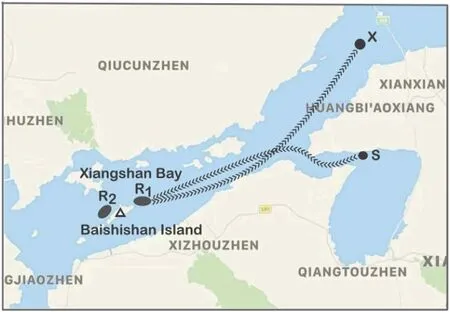
Fig.1.The release areas around Baishishan Island in Xiangshan Bay.
2.1.Traditional stocking method
In the traditional releasing process,fry are hatched at an aquaculture farm and raised to 2-3cm,then moved to sea net cages for 2-4 weeks.The fry are transported to the release area using a boat with an aeration facility and are then released manually with buckets or other tools to the sea.The release site R1(N29°30.633′,E121°36.650′)was the junction station of the northern and southern tides(Fig.1).The water flow is faster than other areas around the island and there were some reefs in this area.The fry were moved using buckets from the Gaoni Sea area(Point S in Fig.1)to the boat with a water tank inside.The boat cruised from Gaoni(Point S)to Guiyuzui(Area R1).The fry were loaded from 8:30 to 9:30 a.m.The boat arrived at Guiyuzui area at 11:30 and the release was completed at 12:00 p.m.using buckets.The temperature was approximately 36°C.The fry were tagged with a plastic tag on the upper fin(Fig.2).Prior to release,the S.macrocephalus fry were bred in sea cages in the Gaoni village sea area.In total,6000 4-6cm fry were released,of which 1500 were tagged.The plastic tag included a telephone number,so that the information of captured fish could be reported to the researcher.The fry stayed at the surface of the water after tagging because of the anesthetic effect.
2.2.In situ stocking method
In comparison with the traditional method above,an in situ stocking method was used in Area R2(Fig.1).The stocking area is important for generating effective results.The ecological characteristics of the preferred habitat of the released species are key factors to be considered.For the offshore island sea area,some fishes,such as S.macrocephalus,stay close to the reef.S.macrocephalus fry cannot survive in highly variable tidal areas,with small tidal variation most suitable.Another important aspect is sufficient food.The selected area should have high food availability to increase the ecosystem carrying capacity,increasing the likelihood that released fry survive the initial stages and avoid predation.Since the fry cannot survive high tidal variations,releasing them during a static tidal environment would be benefi cial.Since the tide varies every 6 h,a release at low tide would be the suitable.After the low tide,the released fry would swim to the shore during the rising tide.Then during the falling tide,the fish could return to the release site,resulting in sufficient time for the fry to adapt the environment.It is necessary to determine an effective tagging method to distinguish the released fish from the wild population to evaluate the effectiveness of stocking.Since it is difficult to tag small fry at a large scale using the traditional tagging method,a technique applying the ear crystal Sr+element fingerprint analysis principle was deemed more suitable.Sr+tagging technique is suitable for large quantity of fish,tagging up to 1 million of fry in one batch.The labor cost for tagging is not proportional to the quantity of the fish compared with the traditional method.The ear crystal is a carbonate mineral structure deposit on thefish inner ear.In living fishes,the chemical element is steadily deposited on the ear crystal after metabolism.This element is stable and not easily absorbed,making it easy to identify for information input and recording.Ear crystal element content is tightly linked with the aquatic habitat of the species.The variation of the elements in surrounding water will alter the ear crystal fingerprint tag.Sr+is the most suitable element for the ear crystal fingerprint tagging research.Sr and Ca are congener elements with the same biological function.The Sr/Ca ratio value in the ear crystal is closely related to that in water.The Sr/Ca information recorded in the ear crystal is widely used to study fish school reorganization,living processes,and living environmental reconstructions.The testing process of Sr+in ear crystals is as seen in Fig.3.
Fish are generally released using a boat from one site to another.However,many fish species cannot adapt to intensive environmental change and exhibit a stress response.In situ stocking is a suitable method to overcome this problem,in which the fry are cultured in net cages for a certain time before release,and thereby have sufficient time to adapt to the surrounding environment.

Fig.2.The plastic tag and tagged fish in the sea cage.
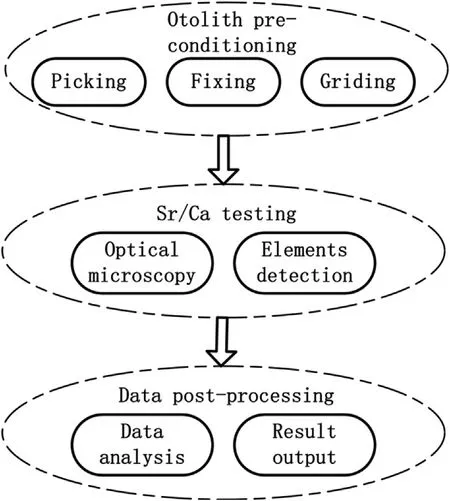
Fig.3.The testing process of Sr+in ear crystals.
Since S.macrocephalus is carnivorous,the fry attack each other and the Matthew effect occurs,where smaller fish leave the food and swim around the net cage,allowing bigger fish more opportunity to obtain food,and therefore grow faster.The experiment from the previous year showed that the fry were generally even at the beginning(Fig.4a)and the fish increased in length from 5 to 13cm after 1mo(Fig.4b).To avoid the phenomena,a sieve wais used to allow the smaller fish access to the food.The sieve was changed every 7d with the growth of thefish,resulting in more uniform fish growth.
The fry were released at 8:20 a.m.on August 21,at a low tide.The net cage was opened underwater and the fish left the cage naturally(Fig.5).To help the released fry adapt to the environment,the fish were fed automatically for 1mo,and some fish returned for food.
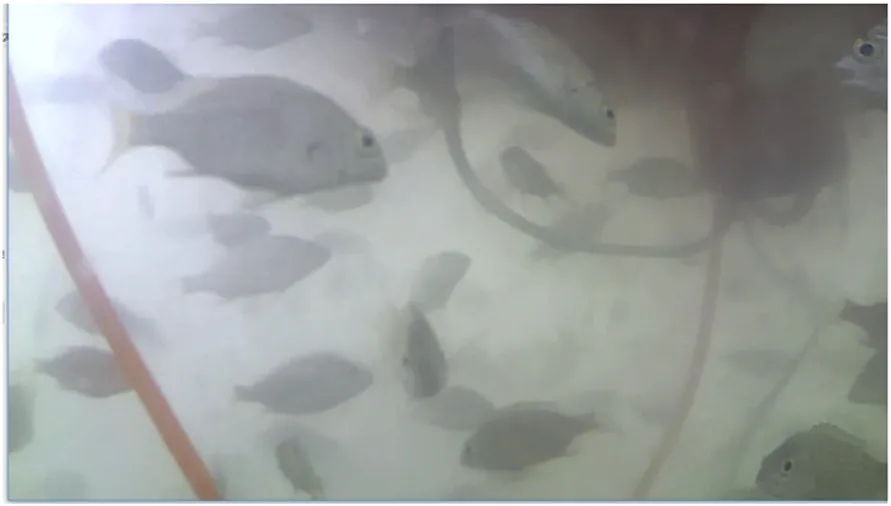
Fig.5.Natural release with the net cage opening underwater.
The fry are released by opening the net cage naturally without using transportation tools,such as buckets,allowing the released fry to return to feed and provides a gradual adaptation process to natural predation.Area R2is at the low-lying area of the Baishishan Island(Fig.1).The tide is gentler here than in other areas and there were some natural and artificial reefs around this area.
There are three stages for the in situ stocking method.Stage 1 applied a double pulse Sr+tagging technique to distinguish the released fry from wild fry.Tagging occurred in the nursery grounds for 7 d in Sr+water.In the first 3 d,the Sr+concentration was 18 mg/L.In the following 2 d,the Sr+concentration was 6 mg/L and in the last 3 d,the Sr+concentration was 18 mg/L.The total culture period was 20 d.
The tagged fry were bred in the net cage in R2from August 1-20 in Stage 2(Fig.1).An automatic feeder was designed and applied in the net cage(Fig.6).The feeder could be set according to the time with precise quantity control.Sound is a natural factor that attracts fish to a reef(Bhandiwad,Whitchurch,Colleye,Zeddies,&Sisneros,2017;Leis,Carson-Ewart,Hay,&Cato,2003;Simpson,Meekan,Montgomery,McCauley,&Jeffs,2005;Tolimieri,Jeffs,&Montgomery,2000).Research(Jiang et al.,2008;Teodosio,Paris,Wolanski,&Morais,2016;Tlusty,Andrew,Baldwin,&Bradley,2008;Zion&Barki,2012;Zhang,Tian,Xu,Jiang,&Yu,2004)has indicated that sound can affect fish behavior.Therefore,a 600Hz signal was played before feeding to attract the fry according to the biological characteristics of S.macrocephalus(Zhang et al.,2004).
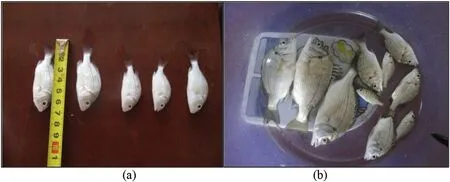
Fig.4.The Matthew effect during the culture of fish in net cages.(a)Fry at the beginning of culture and(b)Fish after 1mo of culture.
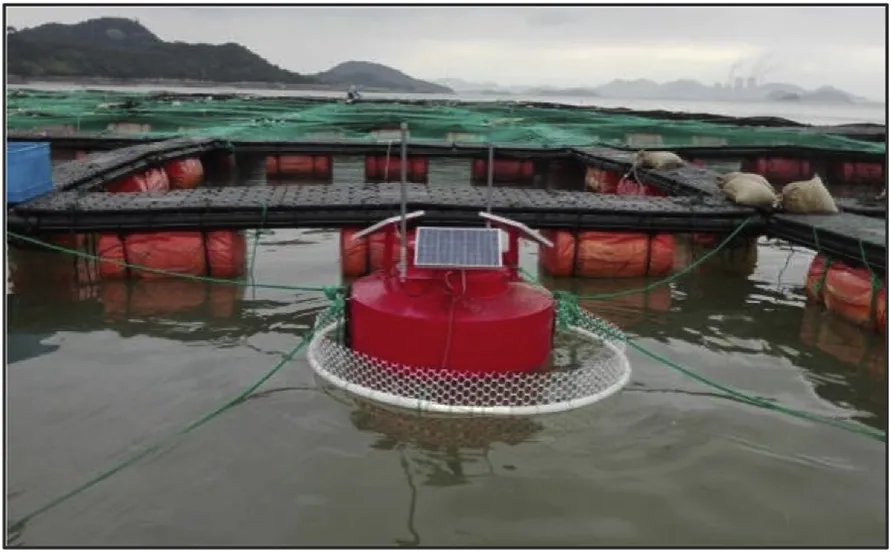
Fig.6.Automatic feeding machine with time and quantity precise control.
After the acoustic conditioning,the net cage was opened which allow the fish to swim out naturally during Stage 3.The automatic feeder continued to work and the fish that swam out could come back for food if there was not enough food in the nature sea water.This process took 3d and the feeder was removed from the net cage and kept working for another 3d before the automatic feeder was moved to 500 m away from the net cage.
3.Results and discussion
3.1.Traditional fish stocking process and effect
The traditional tagging method attached the label to the dorsal fin of the fishes.This cost-and labor-intensive process took 3 people 2 days to finish.Some tagged fry were tangled in the small rope with the cages.At least 42 fish died prior to release for several reasons.35 fishes died in the following 2 days while the tag was fi xed on the lateral line.Since,the fish cannot survive outside the water for an extended time,the tagging operator must work precisely and pro fi ciently.
In the following 30d after release,17 fry were caught and reported by the fishermen and anglers.The occupancy ratio of the tagged fishes is less than 3%.One fish was found at Point X,which is located 20km from R1(Fig.1).The average distance that the fry traveled was 7.6 km 9 fish were found dead,according to the fishermen.However,more than half of the fish did not survive,which showed the fish were not released in a favorable habitat,or the release method was not effective.This could be attributed to the release time,which was at noon,when the light is strong and the water temperature is high.The surface temperature is 30.4°C,and S.macrocephalus is a bottom fish,and does not like strong light.The release point was at the south and north tidal convergence,which has high turbulence.The released fry transition from the stable water and the subsequent environmental change could result in a negative stress response.It is also possible that the tagged fish were physically hurt and lost their ability to find suitable habitat in the nearby area.
The fry were released in a highly stressed state,which heavily affects their ability to adapt to the natural environment.Furthermore,large numbers of fry in a high density produce increased predation.In addition,the traditional tagging method usually leads to in flammation and decreased swimming ability,which would also affect the ability to overcome predation.Therefore,the traditional stocking method was not effective in determining the most effective stocking area,justifying the inclusion of a new stocking technique.
3.2.Fish stocking effect using new technique
The fish were analyzed using ICP-MS and it was determined if the Sr+ fingerprint had deposited on the ear crystal.Tagging was found 0.24-0.38 mm from the center of the ear crystal,where the Sr/Ca value of the tagging section dramatically increased(Figs.7 and 8).
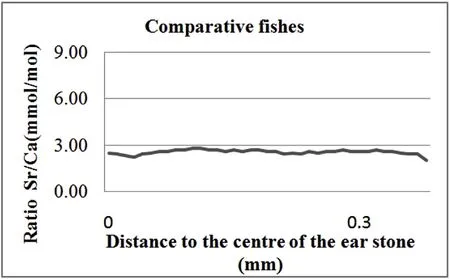
Fig.7.The ratio Sr/Ca in ear crystal without Sr+depositing in marine environments.

Fig.8.The double pulses ratio Sr/Ca in generalear crystalwith Sr+depositing for in situ releasing.
Three regions in the neighboring ocean were selected as comparative areas to track the released fish.In total,354 fishes were caught by angling.Only one fish that was tagged with a double pulse ear crystal was found 3.5km from the release point.All other fishes were found within 1km of the release point in the following 6mo.The results showed the taggedfry survived for a relatively long time,suggesting the new stocking method was effective for realizing regional population gains.
The fish density of the release point was 3.56 times higher than that of Guiyuzui(R1in Fig.1),suggesting the release site selection is important for survival.Together with the other batch of released fish,the tagged fish contributed to 70.8%,39.6%,31.6%,and 29.5%,of the total catch four times,respectively,in the following six months,suggesting a stable survival rate after 45 days(Fig.9).The stomach analysis of released fish showed similar predation ability to untagged fish after 45 days.
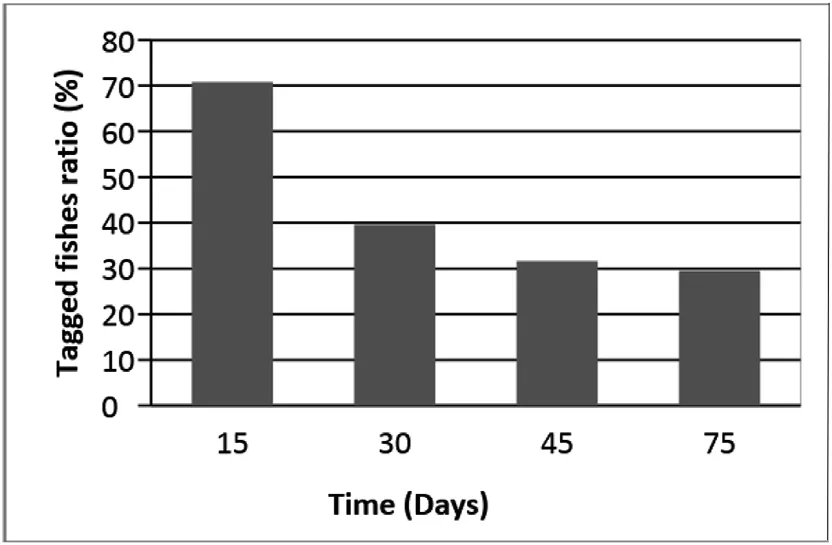
Fig.9.The occupation ration of the tagged fishes among all caught.

Table 1 Effectiveness comparison between traditional and in situ stocking method.

Fig.10.In situ stocking process based on the natural environment.
Some performances of the two stocking methods are show in Table 1.The average traveled distance of the tagged fish for the in situ stocking method is<1 km,which is much shorter than that of the traditional stocking method.The occupancy ratios in the two releasing locations are<3%and 29.5%respectively.That the effectiveness of the in situ stocking method is much better compared with the traditional method can be acquired,though the mortality of the traditional tagging method is higher than that of the Sr+tagging technique,and the environments of the two releasing locations are different.
4.Conclusions
It is fundamental to ensure survival for stocked fish through the first several days and to avoid predation in the natural environment(Pursche,Suthers,&Taylor,2014).In this study,S.macrocephalus was used to analyze traditional and new stocking methods and their shortcomings,considering offshore island environmental factors.Compared with the Sr+tagging method,traditional tagging method produced negative affection to the releasing effect.Even so,the results still clearly showed the simple release method was generally not effective.The in situ stocking strategy was more effective than the traditional method due to multiple factors,which should be considered for future iterations.
Release site,tide,and time are critical.The environment around the island is complex regarding water flow and nutrition.Physical,chemical,and biological factors including water flow,light,temperature,water depth,atmospheric pressure,nutritive salt,dissolved oxygen,pollution,marine microorganisms,algae,and predators,should be considered comprehensively.
In situ release should be evaluated based on cost and pro fi t.The in situ release improved he adaptability of fish to the environment through net cage culture and had a higher fry survival rate than the traditional method in this experiment.This will inevitably increase the cost of fish release.However,since the results are considerably better,the cost and pro fi t could be easily evaluated.In situ release facilitates adaptation to the environment,extends the releasing process,and reduces stress response.The net cage can be dragged by the boat directly to the release site,instead of using buckets and aerated storage on board.Three to five days are required for the net cage to remain at the released site.
Slow movement of the released fish will improve the survival ratio(Kitada&Kishino,2006).In the traditional releasing method,the fry usually are released at once,which results in a high fry density in a short time.The in situ releasing allows the fry move out of the cage freely and provides sufficient time for adaptation to the environment.
Compared with the traditional tagging method,the largest shortcoming of new technique is that its tagging label cannot be observed directly by eyeand mustbeidentified back in a laboratory.Investigations should be designed to prevent loss of tagged fish.Special equipment is necessary to accomplish the whole process.Acoustic techniques will help to keep the fish in the regional area and provide necessary food during key stages.After the release,the equipment can continue operation for certain period to provide necessary food for the released fry to increase their survival.
The strategy discussed above is shown in Fig.10.The released fry can remain in the suitable habitat,which will enhance their survival.Once the fry have adapted to predation threats,they disperse to more suitable habitats.The prolonged release process allows for the fry to adapt to the natural environment.Naturally controlled release is an important segment of the whole releasing technology.
Declarations of interest
None.
Acknowledgments
The study was financially supported by the National Natural Science Foundation of China(No.51309150)and Special Fund for Agro-scienti fi c Research in the Public Interest(No.201303047).
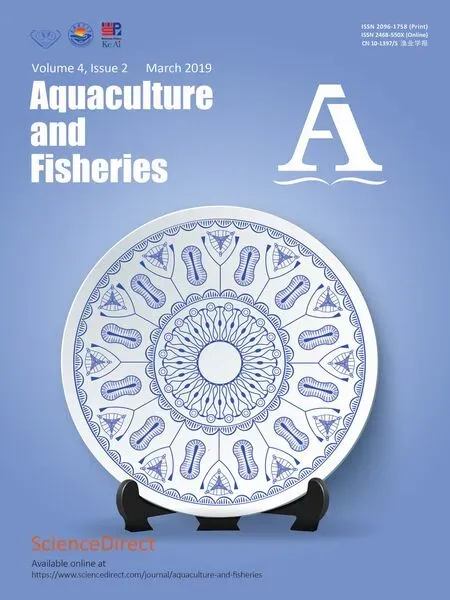 Aquaculture and Fisheries2019年2期
Aquaculture and Fisheries2019年2期
- Aquaculture and Fisheries的其它文章
- Estimationof genetic parameters for juvenile growth performance traits in olive flounder(Paralichthys olivaceus)
- Full-length mRNA sequencing in Saccharina japonica and identification of carbonic anhydrase genes
- Effects of dietary lysolecithin(LPC)on growth,apparent digestibility of nutrient and lipid metabolism in juvenile turbot Scophthalmus maximus L.
- In vivo effects of neomycin sulfate on non-specific immunity,oxidative damage and replication of cyprinid herpesvirus 2 in cruciancarp(Carassius auratus gibelio)
- Current status of research on aquaculture genetics and genomicsinformation from ISGA 2018
